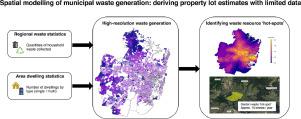Resources, Conservation and Recycling ( IF 11.2 ) Pub Date : 2021-01-29 , DOI: 10.1016/j.resconrec.2021.105442 Ben Madden , Nick Florin , Steve Mohr , Damien Giurco

|
Given recent circular economy policy and waste minimisation targets, there is a significant opportunity to fundamentally change the way waste is managed in Australia, and re-focus waste management to promote resource recovery and efficiency. Detailed data on household waste generation can assist decision makers in targeting waste minimisation incentives, improving resource recovery and circularity, identifying specific technology and infrastructure gaps and informing future development. Unfortunately, high-resolution spatial estimates of waste generation at the property lot scale is typically unavailable. This study presents a novel spatial model developed to estimate waste generation data at the property lot level. Utilising census data at multiple spatial scales and council waste generation data, we apply our model to estimate quantities of residual waste, dry recyclables and garden waste generated for more than 1,200,000 property lots in the Sydney metropolitan area, Australia. Results show the spatial distribution of estimated household waste generation, achieving a high degree of accuracy when compared to validation data. To illustrate the application of our results in the context of identifying ideal areas for waste processing facilities, we analyse the spatial distribution of available garden waste arising from property lots. An area of intense garden waste generation was identified, indicating a supply area of approximately 13km in northern Sydney that can support a facility of approximately 20,000t throughput a year. Our analytical approach presented is novel, and has practical application for locating waste processing facilities; analysing efficient kerbside waste collection services; and in informing data driven urban waste management strategies.
中文翻译:

城市垃圾产生的空间模型:用有限的数据得出物业估计数
鉴于最近的循环经济政策和废物最小化目标,存在巨大的机会从根本上改变澳大利亚废物的管理方式,并重新关注废物管理以促进资源回收和效率。有关家庭废物产生的详细数据可以帮助决策者确定减少废物的诱因,改善资源回收和循环利用,确定具体的技术和基础设施差距以及为未来的发展提供信息。不幸的是,通常无法获得物业规模的废物产生的高分辨率空间估计。这项研究提出了一种新颖的空间模型,该模型用于估算物业批次级别的废物产生数据。利用多个空间尺度的人口普查数据和市政废物产生数据,我们运用我们的模型估算了澳大利亚悉尼都会区超过1,200,000个房地产地段产生的残留废物,干燥可循环利用的废物和花园废物的数量。结果显示了估计的家庭垃圾产生量的空间分布,与验证数据相比,具有很高的准确性。为了说明我们的结果在确定垃圾处理设施的理想区域的背景下的应用,我们分析了物业批次产生的可用花园垃圾的空间分布。确定了密集的花园废物产生区域,表明供应区域约为13公里 结果显示了估计的家庭垃圾产生量的空间分布,与验证数据相比,具有很高的准确性。为了说明我们的结果在确定垃圾处理设施的理想区域的背景下的应用,我们分析了物业批次产生的可用花园垃圾的空间分布。确定了密集的花园废物产生区域,表明供应区域约为13公里 结果显示了估计的家庭垃圾产生量的空间分布,与验证数据相比,具有很高的准确性。为了说明我们的结果在确定垃圾处理设施的理想区域的背景下的应用,我们分析了物业批次产生的可用花园垃圾的空间分布。确定了密集的花园废物产生区域,表明供应区域约为13公里在悉尼北部,每年可支持约20,000吨的产能。我们提出的分析方法是新颖的,并且在定位废物处理设施方面具有实际应用;分析有效的路边废物收集服务;并告知数据驱动的城市废物管理策略。











































 京公网安备 11010802027423号
京公网安备 11010802027423号